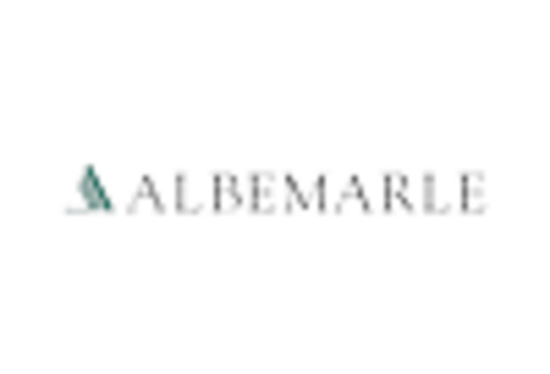Rising Environmental Regulations
The Phase-Transfer Catalyst Market is influenced by the increasing stringency of environmental regulations aimed at reducing hazardous waste and emissions. Governments and regulatory bodies are implementing policies that encourage the use of greener and more sustainable chemical processes. Phase-transfer catalysts are recognized for their ability to enhance reaction efficiency while minimizing environmental impact. As a result, industries are increasingly adopting these catalysts to comply with regulations and achieve sustainability goals. The market is projected to witness a shift towards eco-friendly catalysts, with a potential increase in demand for phase-transfer catalysts that align with these regulatory frameworks. This trend not only supports environmental objectives but also positions the Phase-Transfer Catalyst Market favorably in a landscape that prioritizes sustainability.
Growing Focus on Sustainable Practices
The Phase-Transfer Catalyst Market is increasingly shaped by a growing focus on sustainable practices across various sectors. Companies are recognizing the importance of adopting environmentally friendly processes to meet consumer expectations and regulatory requirements. Phase-transfer catalysts are integral to achieving sustainability in chemical manufacturing, as they facilitate reactions that reduce waste and energy consumption. The market is expected to see a rise in demand for catalysts that not only improve efficiency but also align with sustainability goals. This shift towards sustainable practices is likely to drive innovation within the Phase-Transfer Catalyst Market, as manufacturers strive to develop catalysts that support greener chemistry and contribute to a more sustainable future.
Technological Innovations in Catalysis
The Phase-Transfer Catalyst Market is benefiting from ongoing technological innovations that enhance the efficiency and effectiveness of catalytic processes. Advances in catalyst design, including the development of novel materials and improved synthesis methods, are enabling more efficient phase-transfer catalysts. These innovations are likely to lead to higher reaction rates and better selectivity, which are critical for industries such as pharmaceuticals and agrochemicals. The market is expected to grow as companies invest in research and development to create next-generation catalysts that meet evolving industry demands. Furthermore, the integration of digital technologies in catalyst development is anticipated to streamline processes and reduce time-to-market for new products, thereby positively impacting the Phase-Transfer Catalyst Market.
Increasing Demand for Specialty Chemicals
The Phase-Transfer Catalyst Market is experiencing a notable surge in demand for specialty chemicals, driven by their extensive applications in pharmaceuticals, agrochemicals, and fine chemicals. As industries seek to enhance production efficiency and reduce costs, phase-transfer catalysts facilitate reactions that would otherwise be challenging. The market for specialty chemicals is projected to grow at a compound annual growth rate (CAGR) of approximately 4.5% over the next few years, indicating a robust opportunity for phase-transfer catalysts. This growth is likely to be fueled by the increasing need for innovative solutions in chemical synthesis, where phase-transfer catalysts play a crucial role in improving yields and selectivity. Consequently, the rising demand for specialty chemicals is expected to significantly impact the Phase-Transfer Catalyst Market, creating a favorable environment for market participants.
Expanding Applications in Emerging Markets
The Phase-Transfer Catalyst Market is witnessing an expansion of applications in emerging markets, particularly in regions where industrialization is accelerating. Countries in Asia and Latin America are increasingly adopting phase-transfer catalysts in various sectors, including pharmaceuticals, agrochemicals, and plastics. This trend is driven by the need for efficient chemical processes that can support rapid economic growth. The market in these regions is projected to grow significantly, with an estimated CAGR of around 5% over the next few years. As industries in emerging markets seek to enhance production capabilities and meet international standards, the demand for phase-transfer catalysts is likely to rise, thereby contributing to the overall growth of the Phase-Transfer Catalyst Market.

















Leave a Comment